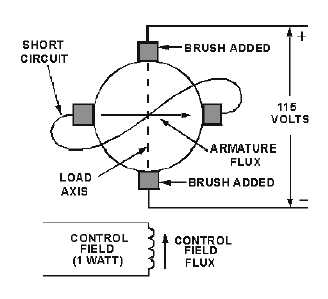1-25
field now requires a control voltage of only 1 volt and an input power of 1 watt (1 volt across 1 ohm
causes 1 ampere of current, which produces 1 watt of input power).
The next step is to add another set of brushes. These now become the output brushes of the
amplidyne. They are placed against the commutator in a position perpendicular to the original brushes, as
shown in figure 1-24. The previously shorted brushes are now called the "quadrature" brushes. This is
because they are in quadrature (perpendicular) to the output brushes. The output brushes are in line with
the armature flux. Therefore, they pick off the voltage induced in the armature windings at this point. The
voltage at the output will be the same as in the original generator, 115 volts in our example.
Figure 1-24.—Amplidyne load brushes.
As you have seen, the original generator produced a 10,000-watt output with a 100-watt input. The
amplidyne produces the same 10,000-watt output with only a 1-watt input. This represents a gain of
10,000. The gain of the original generator has been greatly increased.
As previously stated, an amplidyne is used to provide large dc currents. The primary use of an
amplidyne is in the positioning of heavy loads through the use of synchro/servo systems. Synchro/servo
systems will be studied in a later module.
Assume that a very large turning force is required to rotate a heavy object, such as an antenna, to a
very precise position. A low-power, relatively weak voltage representing the amount of antenna rotation
required can be used to control the field winding of an amplidyne. Because of the amplidyne's ability to
amplify, its output can be used to drive a powerful motor, which turns the heavy object (antenna). When
the source of the input voltage senses the correct movement of the object, it drops the voltage to zero. The
field is no longer strong enough to allow an output voltage to be developed, so the motor ceases to drive
the object (antenna).
The above is an oversimplification and is not meant to describe a functioning system. The intent is to
show a typical sequence of events between the demand for movement and the movement itself. It is meant
to strengthen the idea that with the amplidyne, something large and heavy can be controlled very
precisely by something very small, almost insignificant.
Q22. What is the purpose of a dc generator that has been modified to function as an amplidyne?

